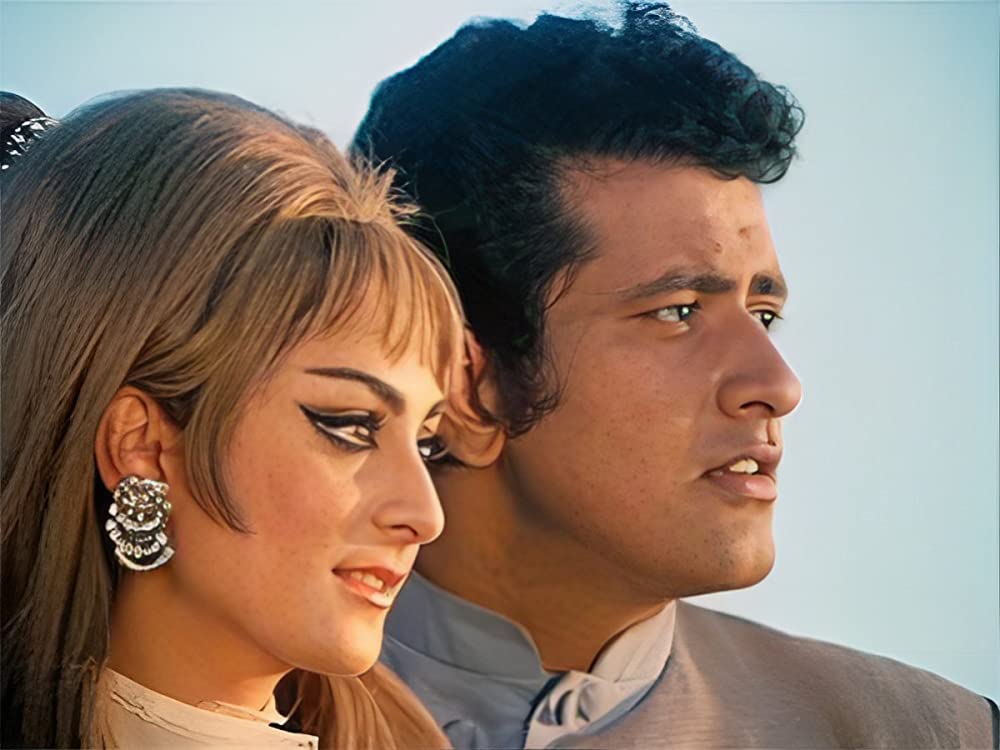Purab Aur Paschim (‘East and West’, 1970) sets up a clear distinction between the Eastern and the Western worlds by comparing the cultures of India and the United Kingdom. This is primarily done in the film by focusing on the human values of the Indian and Western characters, the most important of whom become the two protagonists, Bharat (Manoj Kumar) and Preeti (Saira Banu). While the former acts as the embodiment of Hindu traditions in the film, Preeti has a much more significant role to play — not only is she stuck between the two collocating worlds, but she is also impacted and treated far differently from Bharat due to the various traditional gender norms she is often expected to adhere to, many of which are discussed by Partha Chatterjee in his essay, ‘The Nation and Its Women’ (1999).
Preeti, ever since she is introduced to the viewers in the film, is not just portrayed as a Westernized Indian, but rather, as a proper British person who speaks broken Hindi, wears Western outfits, and has even dyed her hair blonde in order to be perceived as a white woman. On top of that, her lifestyle can be compared to that of the men in the film. However, despite the freedom and agency provided to her within the Purab Aur Paschim universe, she remains a part of a patriarchal society, though in a Western country. Chatterjee talks about the “…construct of woman as a sex object in Western patriarchy…” by mentioning how free-spirited women were often viewed as “sex objects” during the nineteenth century.
This is something that is brought out in the film when the character of Omkar (Prem Chopra) misbehaves with Preeti despite her refusal to acknowledge his feelings for her. Omkar goes to all lengths to force her into accepting him due to how much he objectifies her in his mind. During all of these instances, the religious and spiritual Indian man, Bharat, is shown to come to Preeti’s rescue. This, in a way, is done just to establish that Omkar, even after having more material possessions than Bharat, cannot ultimately win over him because the latter’s values make him far superior.
Additionally, the film, in a highly subtle manner, criticizes Preeti’s Western attributes in order to juxtapose her personality traits with those of the Indian characters, particularly Bharat, who eventually becomes her fiancé. She is shown to be someone who disregards Indian traditions and culture, knows absolutely nothing about the Hindu scripture, Bhagavad Gita, and further refuses to wear a traditional Indian saree when Bharat’s mother requests her to do so. Her behavior is then ridiculed in front of many people by her fiancé’s friends in a puppet show they organize.

Chatterjee sheds light upon the ways in which Indians mock Western women while stating, “It was, of course, a criticism of manners, of new items of clothing. What made the ridicule stronger was the constant suggestion that the Westernised woman was fond of useless luxury and cared little for the well-being of the home.” The denunciation of Preeti’s actions and behavior has little to do with her personal ideologies or principles — things that aren’t even explored much in the film — and are, instead, related to her British upbringing. Through this, Purab Aur Paschim tries to establish that Westernization compels one to focus on the material world while forgetting their morals altogether.
In continuation to the previous point, towards the end of the film, Preeti completely embraces Indian values and becomes an “ideal Indian woman” — she pours all of her alcohol into a drain, throws her cigarettes away, wears a saree, covers her head, and sings “Om Jai Jagdish Hare” in a temple with Bharat’s family members. While talking about ideal Indian women, Chatterjee explains how “They must not eat, drink or smoke in the same way as men; they must continue the observance of religious rituals…they must maintain the cohesiveness of family life and solidarity with the kin….”
Preeti’s transformation from a Western woman to an Indian is shown to be a result of her exposure to the moral philosophies of Bharat’s family members. In other words, the change in Preeti’s attitude towards India and its people is symbolic of her discarding the Western world of materialism to choose the Indian or, instead, the Hindu world of spiritualism.
In a nutshell, the change in Preeti’s character from being a Western woman with blond hair to a Hindu woman in a saree with her head covered can be understood as the film’s attempt to criticize Westernization and propagate Indian — mainly Hindu — values. Purab Aur Paschim employs the use of the Western and Indian woman tropes to differentiate between materialism and spiritualism. In Chatterjee’s words, “The home in its essence must remain unaffected by the profane activities of the material world — and woman is its representation.” Preeti, who initially represents the West, is shown to be at peace with herself only when she adopts an Indian lifestyle.





![Thelma [2017] – A Striking Tale of Self-Discovery with Spellbinding Imagery](http://www.highonfilms.com/wp-content/uploads/2017/12/cover-1-768x432.jpg)
